15 September 2023
Weekly Market View
Are the central banks done?
The world’s major central banks are almost done with rate hikes. That was the underlying message from the European Central Bank this week, a message likely to be echoed by policymakers from the US and UK next week.
The Bank of England could hike once or twice more, given persistent wage pressures, but slowing growth, especially in Europe, suggests policymakers will soon be done with their job of taming inflation and shift their focus towards avoiding a hard landing.
We see an opportunity for investors to move their cash into longer-maturity Developed Market government bonds within a diversified allocation. This is because government bond yields typically peak around the time policy rates peak.
The Bank of Japan is an outlier among major central banks, as it warms up to ending its ultra-loose policy due to rising inflation pressure. However, a moderate monetary policy tightening is unlikely to dent the outperformance of Japanese equities.
Has the US yield curve failed as a US recession indicator? What is the outlook for the curve?
Is it time to buy Emerging Market bonds?
Has the JPY bottomed?
Charts of the week: Peak rates positive for bond returns
Bonds have historically outperformed equities during a recession; the bond yield curve bottomed ahead of a recession
Money market expectations of Developed Market policy rates
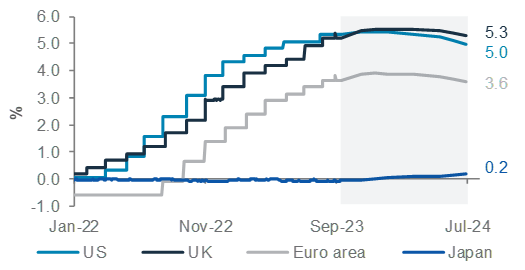
12m returns for US stocks and bonds after recession starts
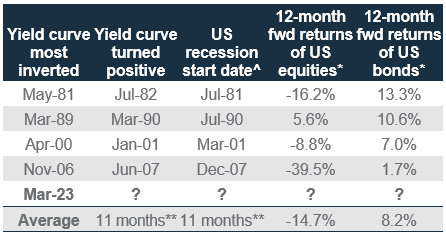
Source: Bloomberg, Standard Chartered; ^excludes 2020 COVID recession; *after recession starts; **from the time yield curve is most inverted
Editorial
Are the central banks done?
The world’s major central banks are almost done with rate hikes. That was the underlying message from the European Central Bank this week, a message likely to be echoed by policymakers from the US and UK next week. The Bank of England could hike once or twice more, given persistent wage pressures, but slowing growth, especially in Europe, suggests policymakers will soon be done with their job of taming inflation and shift their focus towards avoiding a hard landing.
Investment implications: We see an opportunity for investors to move their cash into longer-maturity Developed Market government bonds within a diversified foundation allocation, since government bond yields typically peak around the time policy rates peak (see page 4 for more details). The Bank of Japan is an outlier among major central banks, as it warms up to ending its ultra-loose policy due to rising inflation pressure. However, a moderate monetary policy tightening is unlikely to dent the outperformance of Japanese equities, given the upturn in corporate earnings, rising corporate dividends and buybacks. In FX, the EUR/USD’s sharp decline to a six-month low following the ECB’s dovish hike raises the risk of further downside towards 1.0520 support in the next 2-4 weeks. GBP/USD broke below a key support around its 200DMA at 1.24, opening the way for a test of 1.22 in the coming weeks.
Fed watch: We see low probability of the Fed hiking this month. The Powell-led Fed has rarely surprised markets and markets are not expecting a hike next week. While the US central bank could keep the door open for one last hike in November, given the latest bounce in core inflation to 0.3% m/m, a still-tight job market and the ongoing rebound in oil prices, we expect a downturn in growth later this year to sustain the disinflationary trend. The Fed’s new growth, inflation and rates (‘dot plot’) forecasts will be keenly watched. Any upward revision of the median long-run rate
estimate would signal that the Fed believes rates are not tight enough despite the 525bps of hikes in this cycle, taking rates to a 22-year high.
Do we still get a US recession? A US recession over the next 6-12 months remains our base case. The US Leading Indicator (LEI) has reported a y/y decline for the past 16 months. The US has never avoided a recession after such a long stretch of decline in the indicator. Similarly, the US government bond yield curve has remained inverted (shorter tenure bond yields have remained above longer tenure bond yields, an unusual phenomenon) since July last year. At its extreme in March and July this year, the US 10-year bond yield was almost 111bps lower than the 2-year yield, the biggest inversion since 1981. Historically, a US recession has started 9-22 months (median: 16 months) after the 10-year yield fell below the 2-year yield (this cycle: July 2022), 2-16 months after the curve became most inverted (this cycle: March and July 2023), and 2-6 months after the curve sustainably turned positive again (yet to happen, although in 1982, the curve turned positive almost a year after the recession had started). Based on this history, there is a high probability of a recession starting anytime from Q4 this year to Q2 2024.
A near-term upturn?: While the unusually rapid pace of rate hikes in this cycle raises the odds of a recession, the long historical lags and the wide ranges mean we should not be surprised if a recession started as late as mid-2024. Indeed, this cycle has been extended by the unprecedented fiscal stimulus during COVID, leading to a consumption boom, and the follow up stimulus from President Biden’s green infrastructure fiscal package, leading to a rebound in manufacturing capex. Nevertheless, we expect the impact of high policy rates, depletion of excess consumer savings and fading of the fiscal stimulus to eventually lead to a downturn in economic activity over the next 6-12 months, forcing the central banks to start cutting rates next year. Rate cuts next would provide a fillip to Developed Market government bonds.
— Rajat Bhattacharya
The weekly macro balance sheet
Our weekly net assessment: On balance, we see the past week’s data and policy as neutral for risk assets in the near term
(+) factor: China activity stabilising, credit expansion, ECB rate peak
(-) factor: Rising US inflation, geopolitical tensions
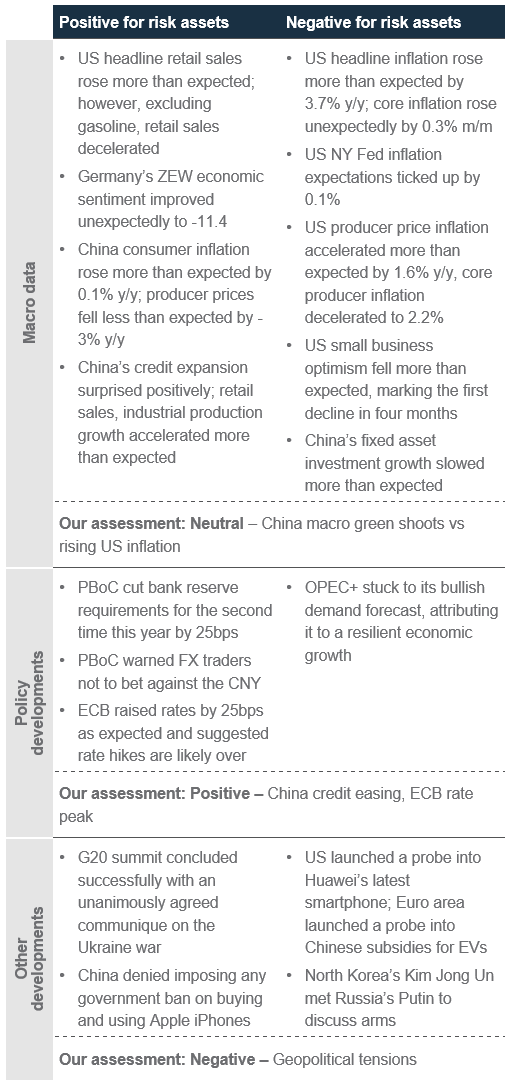
US headline inflation rose more than expected in August due to rise in gasoline and shelter prices
US headline, core and supercore* inflation
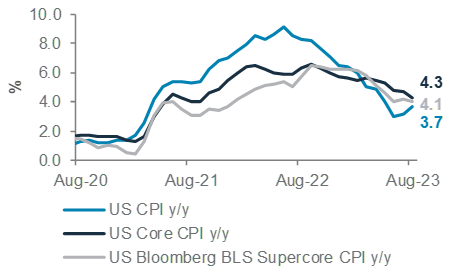
Euro area economic sentiment and expectations remain downbeat
Euro area ZEW survey of current sentiment and growth expectations
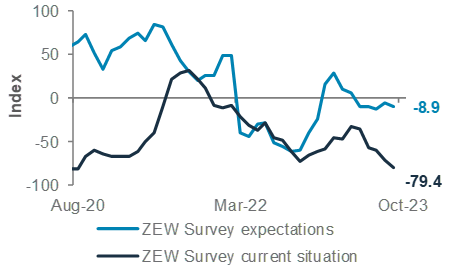
China retail sales and industrial production growth accelerated more than expected in August, but fixed asset investment slowed more than expected
China’s retail sales, industrial production and fixed asset investment growth
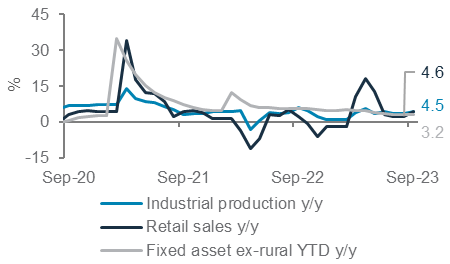
Top client questions
Has the yield curve failed as a recession indicator? What is the outlook for the yield curve from here?
An inverted yield curve, a term used to describe periods when long-term bond yields are lower than short-term bond yields, is commonly used as an indicator of recession. In the last four US cycles, when the 10-year versus 2-year yield curve (10Y2Y) became inverted, a recession typically followed in the next 2 to 16 months. In this cycle, the 10Y2Y yield curve has been persistently inverted since July 2022 and the US economy is still running hot. Here we try to explore what makes this cycle so different.
1. The COVID-19 stimulus ‘bazooka’ has likely extended the longevity of this cycle. Households were able to accumulate excess savings from handouts during the pandemic, which helped sustained a more extended period of stronger-than-expected spending than previous cycles.
2. Although global central banks have been raising interest rates at an unusually rapid rate, earnings data and credit ratings suggest the corporate sector seems to have uphold strong business activities and hence extended the economic lifecycle.
Having said that, we retain our view that a US recession remains likely in 2024. We believe the stimulus/surplus savings from the COVID-19 era is running out of steam. Financial conditions have tightened, predominantly due to higher interest rates. The negative effect of both is already visible in several leading economic indicators.
We believe odds favour a steeper (ie, less inverted) yield curve from here. The Fed has likely reached the end of this hiking cycle, abating upside pressure on short-term yields. In addition, we expect the Fed to cut interest rate in 2024 in response to weaker economic growth. Our analysis of recession episodes since 1980s shows (1) it has taken average 11 months for the 10Y2Y curve to return to the positive territory after it bottoms and (2) the 10Y2Y steepened across all recessions by an average of 139bps.
— Cedric Lam, Senior Investment Strategist
— Qi Xiu Tay, Investment Strategist
The US 10Y2Y government bond yield curve has steepened across all recession episodes we studied since the 1980s
The trough of the 10Y2Y yield curve inversion, months it took to return to positive and measure of yield curve steepening (bps) during recession
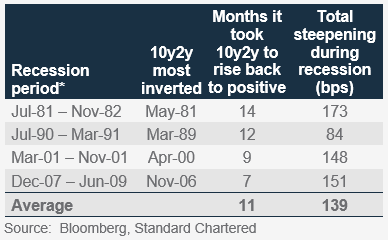
Top client questions (cont’d)
Is it time to buy Emerging Market bonds?
Emerging Market (EM) USD and local currency bonds have pulled back after hitting their 2023 high in July. A rise in US government bond yields and the strength in the USD, respectively, have been the key drivers for the subdued performance. While we think the pullback offers a good entry point for EM local currency bonds, we would still remain cautious on EM USD government bonds.
Historically, FX returns have been a prominent driver for EM local currency bonds. While the recent bounce in the USD has undoubtedly hurt them, we expect the USD to weaken over the next 12 months, which should provide a returns tailwind. Additionally, EM central banks are further along the interest rate cycle than their DM counterparts. We are close to the peak of a hiking cycle for most EM countries, and some have even started cutting rates, which should again be supportive for returns.
While credit spreads or yield premiums for EM USD government bonds look optically attractive, they are justified to compensate investors for the deterioration in credit quality. Spreads of IG sovereign bonds are in fact quite expensive relative to historical average. It could be argued that the elevated HY spreads are still insufficient to compensate investors for the increase in default risk. Hence, we remain Underweight on EM USD government bonds.
— Abhilash Narayan, Senior Investment Strategist
EM USD IG government bond yields premiums are fairly expensive; HY spreads are justifiably high due to deterioration in credit quality
EM USD government bond IG and HY sub-index yield premiums
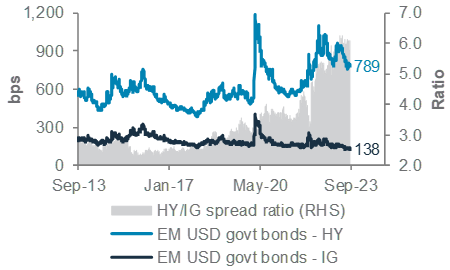
Has the JPY bottomed?
USD/JPY’s bullish trend continued to push fresh highs in the first week of September. However, towards the end of last week, Ueda said ending negative rates would be an option once the BoJ’s goal of sustainable 2% inflation is achieved. With Japan’s latest improved GDP growth and inflation data recently, currently the market is expecting BoJ to end negative rates by early 2024. The JPY gained strength as the 10-year JGB rate moved higher (rose to 0.71%, its highest since January 2014) and limited the latter’s upside risk.
On the other side, the Fed is expected to maintain policy rates for an extended period, while interest rates in Japan are not likely to rise significantly, even if the BoJ ends its negative rate policy. This means the JPY could continue facing downward pressure before any new updates from either the Fed or BoJ. Meanwhile, the Greenback looks overvalued now with technical correction risk; therefore, we expect USD/JPY to rangebound with a bearish bias. Technically, the pair is trading above 50d SMA, its relative strength index is in a neutral zone at 59 but at the edge of its Bollinger band upper bound, and the upside risk is limited with significant resistance at 151.90. The pair is likely to test its support at 144.40 in the upcoming 2-3 weeks.
— Iris Yuen, Investment Strategist
USD/JPY surged alongside the interest rate differential between the US and Japan, but is now close to a technical resistance
USD/JPY and interest rate differentials
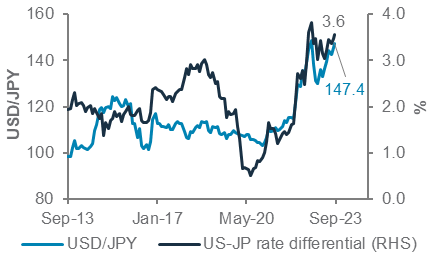
Top client questions (cont’d)
What are the implications of the Bank of Japan’s recent hawkish comments on Japanese equities?
BoJ Governor Ueda’s interview last week hinted at a potential end to Japan’s negative interest rate regime. In response to his hawkish comments, the JGB 10-year yield has surged to above 0.7% ahead of the BoJ policy meeting next week – a level not seen since 2014.
Overall, Japan remains our preferred equity market on a 6-12 month horizon amid its relatively relaxed monetary policies, as compared with other developed markets, and measures to support corporate governance. We expect the potential relaxation in its prolonged Yield Curve Control policy to be supportive of the financial sector in particular, because major domestic banks benefit from higher interest income. The MSCI Japan Financial index has been outperforming the broader Japan market this year, rising almost 50% YTD. However, valuations remain appealing, with the sector’s 12m forward P/E currently trading at 11.7x, below its historical averages, despite elevated 12m forward EPS growth expectations of 12.4% – substantially above the expected earnings growth in the broader Japan market.
— Michelle Kam, Investment Strategist
Performances of Japan’s financial sector is closely related to its government bond yield
Relative performance of MSCI Japan Financials index and JGB 10y yield
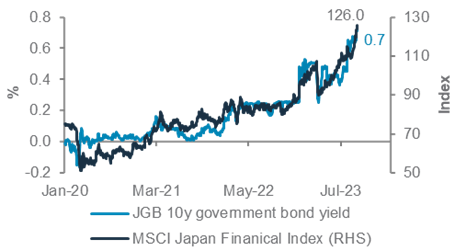
Market performance summary*
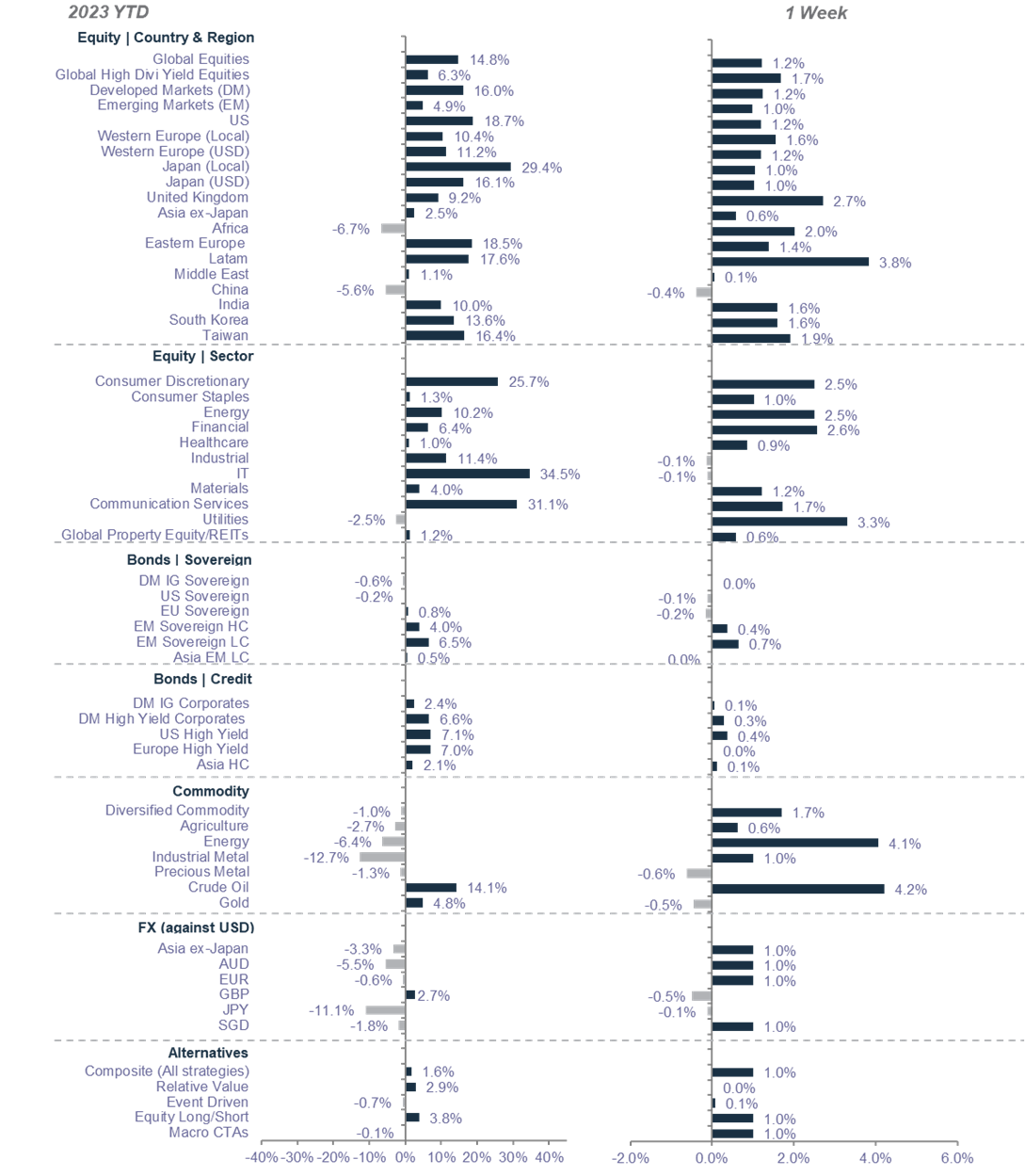
Our 12-month asset class views at a glance
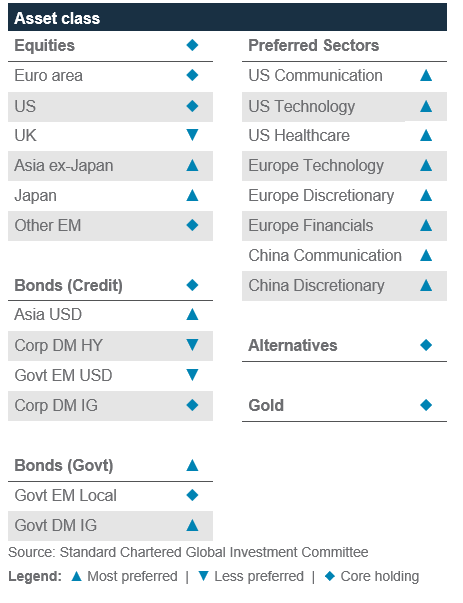
Economic and market calendar
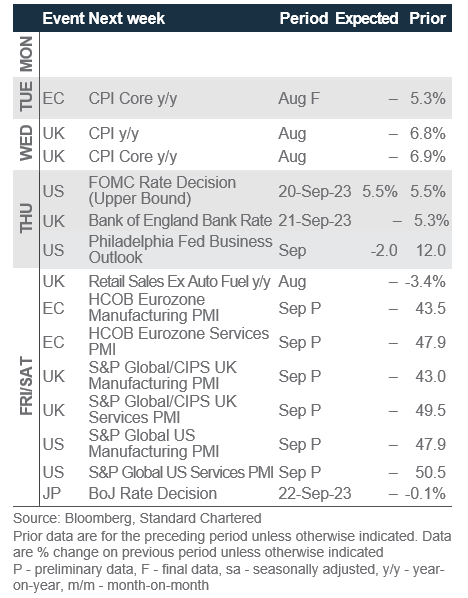
The next resistance for the US 10Y bond yield is at 4.30%
Technical indicators for key markets as of 14 September close
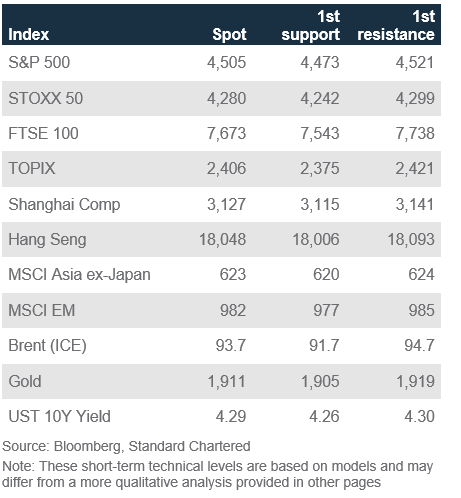
Investor diversity is healthy in global equities and bonds
Our proprietary market diversity indicators as of 14 September
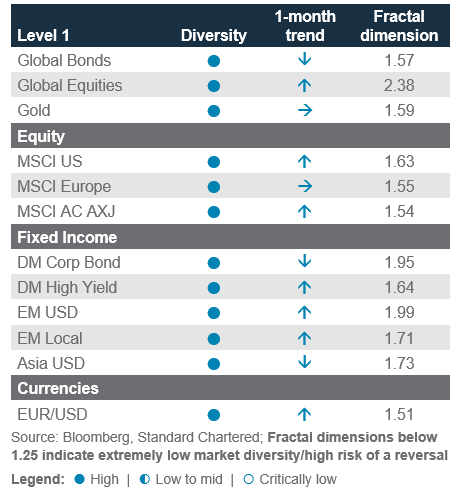
For more CIO Office insights
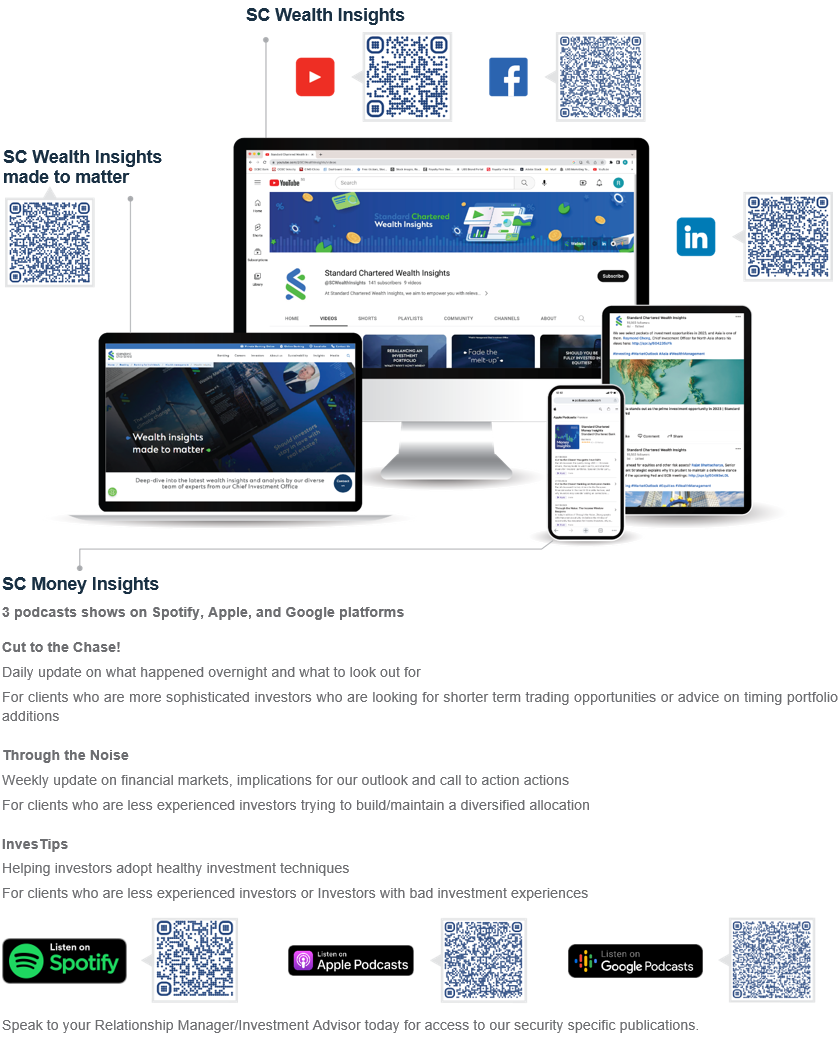
Disclosure
This document is confidential and may also be privileged. If you are not the intended recipient, please destroy all copies and notify the sender immediately. This document is being distributed for general information only and is subject to the relevant disclaimers available at our Standard Chartered website under Regulatory disclosures. It is not and does not constitute research material, independent research, an offer, recommendation or solicitation to enter into any transaction or adopt any hedging, trading or investment strategy, in relation to any securities or other financial instruments. This document is for general evaluation only. It does not take into account the specific investment objectives, financial situation or particular needs of any particular person or class of persons and it has not been prepared for any particular person or class of persons. You should not rely on any contents of this document in making any investment decisions. Before making any investment, you should carefully read the relevant offering documents and seek independent legal, tax and regulatory advice. In particular, we recommend you to seek advice regarding the suitability of the investment product, taking into account your specific investment objectives, financial situation or particular needs, before you make a commitment to purchase the investment product. Opinions, projections and estimates are solely those of SC at the date of this document and subject to change without notice. Past performance is not indicative of future results and no representation or warranty is made regarding future performance. The value of investments, and the income from them, can go down as well as up, and you may not recover the amount of your original investment. You are not certain to make a profit and may lose money. Any forecast contained herein as to likely future movements in rates or prices or likely future events or occurrences constitutes an opinion only and is not indicative of actual future movements in rates or prices or actual future events or occurrences (as the case may be). This document must not be forwarded or otherwise made available to any other person without the express written consent of the Standard Chartered Group (as defined below). Standard Chartered Bank is incorporated in England with limited liability by Royal Charter 1853 Reference Number ZC18. The Principal Office of the Company is situated in England at 1 Basinghall Avenue, London, EC2V 5DD. Standard Chartered Bank is authorised by the Prudential Regulation Authority and regulated by the Financial Conduct Authority and Prudential Regulation Authority. Standard Chartered PLC, the ultimate parent company of Standard Chartered Bank, together with its subsidiaries and affiliates (including each branch or representative office), form the Standard Chartered Group. Standard Chartered Private Bank is the private banking division of Standard Chartered. Private banking activities may be carried out internationally by different legal entities and affiliates within the Standard Chartered Group (each an “SC Group Entity”) according to local regulatory requirements. Not all products and services are provided by all branches, subsidiaries and affiliates within the Standard Chartered Group. Some of the SC Group Entities only act as representatives of Standard Chartered Private Bank and may not be able to offer products and services or offer advice to clients.
Copyright © 2025, Accounting Research & Analytics, LLC d/b/a CFRA (and its affiliates, as applicable). Reproduction of content provided by CFRA in any form is prohibited except with the prior written permission of CFRA. CFRA content is not investment advice and a reference to or observation concerning a security or investment provided in the CFRA SERVICES is not a recommendation to buy, sell or hold such investment or security or make any other investment decisions. The CFRA content contains opinions of CFRA based upon publicly-available information that CFRA believes to be reliable and the opinions are subject to change without notice. This analysis has not been submitted to, nor received approval from, the United States Securities and Exchange Commission or any other regulatory body. While CFRA exercised due care in compiling this analysis, CFRA, ITS THIRD-PARTY SUPPLIERS, AND ALL RELATED ENTITIES SPECIFICALLY DISCLAIM ALL WARRANTIES, EXPRESS OR IMPLIED, INCLUDING, BUT NOT LIMITED TO, ANY WARRANTIES OF MERCHANTABILITY OR FITNESS FOR A PARTICULAR PURPOSE OR USE, to the full extent permitted by law, regarding the accuracy, completeness, or usefulness of this information and assumes no liability with respect to the consequences of relying on this information for investment or other purposes. No content provided by CFRA (including ratings, credit-related analyses and data, valuations, model, software or other application or output therefrom) or any part thereof may be modified, reverse engineered, reproduced or distributed in any form by any means, or stored in a database or retrieval system, without the prior written permission of CFRA, and such content shall not be used for any unlawful or unauthorized purposes. CFRA and any third-party providers, as well as their directors, officers, shareholders, employees or agents do not guarantee the accuracy, completeness, timeliness or availability of such content. In no event shall CFRA, its affiliates, or their third-party suppliers be liable for any direct, indirect, special, or consequential damages, costs, expenses, legal fees, or losses (including lost income or lost profit and opportunity costs) in connection with a subscriber’s, subscriber’s customer’s, or other’s use of CFRA’s content.
Market Abuse Regulation (MAR) Disclaimer
Banking activities may be carried out internationally by different branches, subsidiaries and affiliates within the Standard Chartered Group according to local regulatory requirements. Opinions may contain outright “buy”, “sell”, “hold” or other opinions. The time horizon of this opinion is dependent on prevailing market conditions and there is no planned frequency for updates to the opinion. This opinion is not independent of Standard Chartered Group’s trading strategies or positions. Standard Chartered Group and/or its affiliates or its respective officers, directors, employee benefit programmes or employees, including persons involved in the preparation or issuance of this document may at any time, to the extent permitted by applicable law and/or regulation, be long or short any securities or financial instruments referred to in this document or have material interest in any such securities or related investments. Therefore, it is possible, and you should assume, that Standard Chartered Group has a material interest in one or more of the financial instruments mentioned herein. Please refer to our Standard Chartered website under Regulatory disclosures for more detailed disclosures, including past opinions/ recommendations in the last 12 months and conflict of interests, as well as disclaimers. A covering strategist may have a financial interest in the debt or equity securities of this company/issuer. All covering strategist are licensed to provide investment recommendations under Monetary Authority of Singapore or Hong Kong Monetary Authority. This document must not be forwarded or otherwise made available to any other person without the express written consent of Standard Chartered Group.
Sustainable Investments
Any ESG data used or referred to has been provided by Morningstar, Sustainalytics, MSCI or Bloomberg. Refer to 1) Morningstar website under Sustainable Investing, 2) Sustainalytics website under ESG Risk Ratings, 3) MCSI website under ESG Business Involvement Screening Research and 4) Bloomberg green, social & sustainability bonds guide for more information. The ESG data is as at the date of publication based on data provided, is for informational purpose only and is not warranted to be complete, timely, accurate or suitable for a particular purpose, and it may be subject to change. Sustainable Investments (SI): This refers to funds that have been classified as ‘Sustainable Investments’ by Morningstar. SI funds have explicitly stated in their prospectus and regulatory filings that they either incorporate ESG factors into the investment process or have a thematic focus on the environment, gender diversity, low carbon, renewable energy, water or community development. For equity, it refers to shares/stocks issued by companies with Sustainalytics ESG Risk Rating of Low/Negligible. For bonds, it refers to debt instruments issued by issuers with Sustainalytics ESG Risk Rating of Low/Negligible, and/or those being certified green, social, sustainable bonds by Bloomberg. For structured products, it refers to products that are issued by any issuer who has a Sustainable Finance framework that aligns with Standard Chartered’s Green and Sustainable Product Framework, with underlying assets that are part of the Sustainable Investment universe or separately approved by Standard Chartered’s Sustainable Finance Governance Committee. Sustainalytics ESG risk ratings shown are factual and are not an indicator that the product is classified or marketed as “green”, “sustainable” or similar under any particular classification system or framework.
Country/Market Specific Disclosures
Botswana: This document is being distributed in Botswana by, and is attributable to, Standard Chartered Bank Botswana Limited which is a financial institution licensed under the Section 6 of the Banking Act CAP 46.04 and is listed in the Botswana Stock Exchange. Brunei Darussalam: This document is being distributed in Brunei Darussalam by, and is attributable to, Standard Chartered Bank (Brunei Branch) | Registration Number RFC/61 and Standard Chartered Securities (B) Sdn Bhd | Registration Number RC20001003. Standard Chartered Bank is incorporated in England with limited liability by Royal Charter 1853 Reference Number ZC18. Standard Chartered Securities (B) Sdn Bhd is a limited liability company registered with the Registry of Companies with Registration Number RC20001003 and licensed by Brunei Darussalam Central Bank as a Capital Markets Service License Holder with License Number BDCB/R/CMU/S3-CL and it is authorised to conduct Islamic investment business through an Islamic window. China Mainland: This document is being distributed in China by, and is attributable to, Standard Chartered Bank (China) Limited which is mainly regulated by National Financial Regulatory Administration (NFRA), State Administration of Foreign Exchange (SAFE), and People’s Bank of China (PBOC). Hong Kong: In Hong Kong, this document, except for any portion advising on or facilitating any decision on futures contracts trading, is distributed by Standard Chartered Bank (Hong Kong) Limited (“SCBHK”), a subsidiary of Standard Chartered PLC. SCBHK has its registered address at 32/F, Standard Chartered Bank Building, 4-4A Des Voeux Road Central, Hong Kong and is regulated by the Hong Kong Monetary Authority and registered with the Securities and Futures Commission (“SFC”) to carry on Type 1 (dealing in securities), Type 4 (advising on securities), Type 6 (advising on corporate finance) and Type 9 (asset management) regulated activity under the Securities and Futures Ordinance (Cap. 571) (“SFO”) (CE No. AJI614). The contents of this document have not been reviewed by any regulatory authority in Hong Kong and you are advised to exercise caution in relation to any offer set out herein. If you are in doubt about any of the contents of this document, you should obtain independent professional advice. Any product named herein may not be offered or sold in Hong Kong by means of any document at any time other than to “professional investors” as defined in the SFO and any rules made under that ordinance. In addition, this document may not be issued or possessed for the purposes of issue, whether in Hong Kong or elsewhere, and any interests may not be disposed of, to any person unless such person is outside Hong Kong or is a “professional investor” as defined in the SFO and any rules made under that ordinance, or as otherwise may be permitted by that ordinance. In Hong Kong, Standard Chartered Private Bank is the private banking division of SCBHK, a subsidiary of Standard Chartered PLC. Ghana: Standard Chartered Bank Ghana Limited accepts no liability and will not be liable for any loss or damage arising directly or indirectly (including special, incidental or consequential loss or damage) from your use of these documents. Past performance is not indicative of future results and no representation or warranty is made regarding future performance. You should seek advice from a financial adviser on the suitability of an investment for you, taking into account these factors before making a commitment to invest in an investment. To unsubscribe from receiving further updates, please send an email to feedback.ghana@sc.com. Please do not reply to this email. Call our Priority Banking on 0302610750 for any questions or service queries. You are advised not to send any confidential and/or important information to Standard Chartered via e-mail, as Standard Chartered makes no representations or warranties as to the security or accuracy of any information transmitted via e-mail. Standard Chartered shall not be responsible for any loss or damage suffered by you arising from your decision to use e-mail to communicate with the Bank. India: This document is being distributed in India by Standard Chartered in its capacity as a distributor of mutual funds and referrer of any other third party financial products. Standard Chartered does not offer any ‘Investment Advice’ as defined in the Securities and Exchange Board of India (Investment Advisers) Regulations, 2013 or otherwise. Services/products related securities business offered by Standard Charted are not intended for any person, who is a resident of any jurisdiction, the laws of which imposes prohibition on soliciting the securities business in that jurisdiction without going through the registration requirements and/or prohibit the use of any information contained in this document. Indonesia: This document is being distributed in Indonesia by Standard Chartered Bank, Indonesia branch, which is a financial institution licensed and supervised by Otoritas Jasa Keuangan (Financial Service Authority) and Bank Indonesia. Jersey: In Jersey, Standard Chartered Private Bank is the Registered Business Name of the Jersey Branch of Standard Chartered Bank. The Jersey Branch of Standard Chartered Bank is regulated by the Jersey Financial Services Commission. Copies of the latest audited accounts of Standard Chartered Bank are available from its principal place of business in Jersey: PO Box 80, 15 Castle Street, St Helier, Jersey JE4 8PT. Standard Chartered Bank is incorporated in England with limited liability by Royal Charter in 1853 Reference Number ZC 18. The Principal Office of the Company is situated in England at 1 Basinghall Avenue, London, EC2V 5DD. Standard Chartered Bank is authorised by the Prudential Regulation Authority and regulated by the Financial Conduct Authority and Prudential Regulation Authority. The Jersey Branch of Standard Chartered Bank is also an authorised financial services provider under license number 44946 issued by the Financial Sector Conduct Authority of the Republic of South Africa. Jersey is not part of the United Kingdom and all business transacted with Standard Chartered Bank, Jersey Branch and other SC Group Entity outside of the United Kingdom, are not subject to some or any of the investor protection and compensation schemes available under United Kingdom law. Kenya: This document is being distributed in Kenya by and is attributable to Standard Chartered Bank Kenya Limited. Investment Products and Services are distributed by Standard Chartered Investment Services Limited, a wholly owned subsidiary of Standard Chartered Bank Kenya Limited that is licensed by the Capital Markets Authority in Kenya, as a Fund Manager. Standard Chartered Bank Kenya Limited is regulated by the Central Bank of Kenya. Malaysia: This document is being distributed in Malaysia by Standard Chartered Bank Malaysia Berhad (“SCBMB”). Recipients in Malaysia should contact SCBMB in relation to any matters arising from, or in connection with, this document. This document has not been reviewed by the Securities Commission Malaysia. The product lodgement, registration, submission or approval by the Securities Commission of Malaysia does not amount to nor indicate recommendation or endorsement of the product, service or promotional activity. Investment products are not deposits and are not obligations of, not guaranteed by, and not protected by SCBMB or any of the affiliates or subsidiaries, or by Perbadanan Insurans Deposit Malaysia, any government or insurance agency. Investment products are subject to investment risks, including the possible loss of the principal amount invested. SCBMB expressly disclaim any liability and responsibility for any loss arising directly or indirectly (including special, incidental or consequential loss or damage) arising from the financial losses of the Investment Products due to market condition. Nigeria: This document is being distributed in Nigeria by Standard Chartered Bank Nigeria Limited (SCB Nigeria), a bank duly licensed and regulated by the Central Bank of Nigeria. SCB Nigeria accepts no liability for any loss or damage arising directly or indirectly (including special, incidental or consequential loss or damage) from your use of these documents. You should seek advice from a financial adviser on the suitability of an investment for you, taking into account these factors before making a commitment to invest in an investment. To unsubscribe from receiving further updates, please send an email to clientcare.ng@sc.com requesting to be removed from our mailing list. Please do not reply to this email. Call our Priority Banking on 02 012772514 for any questions or service queries. SCB Nigeria shall not be responsible for any loss or damage arising from your decision to send confidential and/or important information to Standard Chartered via e-mail. SCB Nigeria makes no representations or warranties as to the security or accuracy of any information transmitted via e-mail. Pakistan: This document is being distributed in Pakistan by, and attributable to Standard Chartered Bank (Pakistan) Limited having its registered office at PO Box 5556, I.I Chundrigar Road Karachi, which is a banking company registered with State Bank of Pakistan under Banking Companies Ordinance 1962 and is also having licensed issued by Securities & Exchange Commission of Pakistan for Security Advisors. Standard Chartered Bank (Pakistan) Limited acts as a distributor of mutual funds and referrer of other third-party financial products. Singapore: This document is being distributed in Singapore by, and is attributable to, Standard Chartered Bank (Singapore) Limited (Registration No. 201224747C/ GST Group Registration No. MR-8500053-0, “SCBSL”). Recipients in Singapore should contact SCBSL in relation to any matters arising from, or in connection with, this document. SCBSL is an indirect wholly owned subsidiary of Standard Chartered Bank and is licensed to conduct banking business in Singapore under the Singapore Banking Act, 1970. Standard Chartered Private Bank is the private banking division of SCBSL. IN RELATION TO ANY SECURITY OR SECURITIES-BASED DERIVATIVES CONTRACT REFERRED TO IN THIS DOCUMENT, THIS DOCUMENT, TOGETHER WITH THE ISSUER DOCUMENTATION, SHALL BE DEEMED AN INFORMATION MEMORANDUM (AS DEFINED IN SECTION 275 OF THE SECURITIES AND FUTURES ACT, 2001 (“SFA”)). THIS DOCUMENT IS INTENDED FOR DISTRIBUTION TO ACCREDITED INVESTORS, AS DEFINED IN SECTION 4A(1)(a) OF THE SFA, OR ON THE BASIS THAT THE SECURITY OR SECURITIES-BASED DERIVATIVES CONTRACT MAY ONLY BE ACQUIRED AT A CONSIDERATION OF NOT LESS THAN S$200,000 (OR ITS EQUIVALENT IN A FOREIGN CURRENCY) FOR EACH TRANSACTION. Further, in relation to any security or securities-based derivatives contract, neither this document nor the Issuer Documentation has been registered as a prospectus with the Monetary Authority of Singapore under the SFA. Accordingly, this document and any other document or material in connection with the offer or sale, or invitation for subscription or purchase, of the product may not be circulated or distributed, nor may the product be offered or sold, or be made the subject of an invitation for subscription or purchase, whether directly or indirectly, to persons other than a relevant person pursuant to section 275(1) of the SFA, or any person pursuant to section 275(1A) of the SFA, and in accordance with the conditions specified in section 275 of the SFA, or pursuant to, and in accordance with the conditions of, any other applicable provision of the SFA. In relation to any collective investment schemes referred to in this document, this document is for general information purposes only and is not an offering document or prospectus (as defined in the SFA). This document is not, nor is it intended to be (i) an offer or solicitation of an offer to buy or sell any capital markets product; or (ii) an advertisement of an offer or intended offer of any capital markets product. Deposit Insurance Scheme: Singapore dollar deposits of non-bank depositors are insured by the Singapore Deposit Insurance Corporation, for up to S$100,000 in aggregate per depositor per Scheme member by law. Foreign currency deposits, dual currency investments, structured deposits and other investment products are not insured. This advertisement has not been reviewed by the Monetary Authority of Singapore. Taiwan: SC Group Entity or Standard Chartered Bank (Taiwan) Limited (“SCB (Taiwan)”) may be involved in the financial instruments contained herein or other related financial instruments. The author of this document may have discussed the information contained herein with other employees or agents of SC or SCB (Taiwan). The author and the above-mentioned employees of SC or SCB (Taiwan) may have taken related actions in respect of the information involved (including communication with customers of SC or SCB (Taiwan) as to the information contained herein). The opinions contained in this document may change, or differ from the opinions of employees of SC or SCB (Taiwan). SC and SCB (Taiwan) will not provide any notice of any changes to or differences between the above-mentioned opinions. This document may cover companies with which SC or SCB (Taiwan) seeks to do business at times and issuers of financial instruments. Therefore, investors should understand that the information contained herein may serve as specific purposes as a result of conflict of interests of SC or SCB (Taiwan). SC, SCB (Taiwan), the employees (including those who have discussions with the author) or customers of SC or SCB (Taiwan) may have an interest in the products, related financial instruments or related derivative financial products contained herein; invest in those products at various prices and on different market conditions; have different or conflicting interests in those products. The potential impacts include market makers’ related activities, such as dealing, investment, acting as agents, or performing financial or consulting services in relation to any of the products referred to in this document. UAE: DIFC – Standard Chartered Bank is incorporated in England with limited liability by Royal Charter 1853 Reference Number ZC18.The Principal Office of the Company is situated in England at 1 Basinghall Avenue, London, EC2V 5DD. Standard Chartered Bank is authorised by the Prudential Regulation Authority and regulated by the Financial Conduct Authority and Prudential Regulation Authority. Standard Chartered Bank, Dubai International Financial Centre having its offices at Dubai International Financial Centre, Building 1, Gate Precinct, P.O. Box 999, Dubai, UAE is a branch of Standard Chartered Bank and is regulated by the Dubai Financial Services Authority (“DFSA”). This document is intended for use only by Professional Clients and is not directed at Retail Clients as defined by the DFSA Rulebook. In the DIFC we are authorised to provide financial services only to clients who qualify as Professional Clients and Market Counterparties and not to Retail Clients. As a Professional Client you will not be given the higher retail client protection and compensation rights and if you use your right to be classified as a Retail Client we will be unable to provide financial services and products to you as we do not hold the required license to undertake such activities. For Islamic transactions, we are acting under the supervision of our Shariah Supervisory Committee. Relevant information on our Shariah Supervisory Committee is currently available on the Standard Chartered Bank website in the Islamic banking section. For residents of the UAE – Standard Chartered Bank UAE does not provide financial analysis or consultation services in or into the UAE within the meaning of UAE Securities and Commodities Authority Decision No. 48/r of 2008 concerning financial consultation and financial analysis. Uganda: Our Investment products and services are distributed by Standard Chartered Bank Uganda Limited, which is licensed by the Capital Markets Authority as an investment adviser. United Kingdom: In the UK, Standard Chartered Bank is authorised by the Prudential Regulation Authority and regulated by the Financial Conduct Authority and Prudential Regulation Authority. This communication has been approved by Standard Chartered Bank for the purposes of Section 21 (2) (b) of the United Kingdom’s Financial Services and Markets Act 2000 (“FSMA”) as amended in 2010 and 2012 only. Standard Chartered Bank (trading as Standard Chartered Private Bank) is also an authorised financial services provider (license number 45747) in terms of the South African Financial Advisory and Intermediary Services Act, 2002. The Materials have not been prepared in accordance with UK legal requirements designed to promote the independence of investment research, and that it is not subject to any prohibition on dealing ahead of the dissemination of investment research. Vietnam: This document is being distributed in Vietnam by, and is attributable to, Standard Chartered Bank (Vietnam) Limited which is mainly regulated by State Bank of Vietnam (SBV). Recipients in Vietnam should contact Standard Chartered Bank (Vietnam) Limited for any queries regarding any content of this document. Zambia: This document is distributed by Standard Chartered Bank Zambia Plc, a company incorporated in Zambia and registered as a commercial bank and licensed by the Bank of Zambia under the Banking and Financial Services Act Chapter 387 of the Laws of Zambia.
